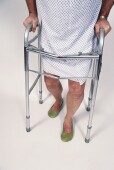
MONDAY, March 15 (HealthDay News) — Older men and women who break a hip are five to eight times more likely to die in the first three months after the fracture, a new study by Belgian researchers has found.
And, while the death rate after a hip fracture diminishes substantially during the first two years after the break, it never returns to the death rate seen in similar people who did not fracture a hip, the study authors said.
“A hip fracture is a major blow to the body,” said Dr. Elton Strauss, an associate professor and chief of orthopedic trauma and adult reconstruction at Mount Sinai School of Medicine in New York City, who was not involved in the study.
Strauss said the main problem is not repairing the fracture itself but the toll it takes on older people.
“It’s actually the problem with the elderly skeleton as well as the co-morbidities [other health problems] these patients have,” he said. “There’s also the mental shock.”
For the study, a team led by Dr. Patrick Haentjens, of the Centre for Outcomes Research and the Laboratory for Experimental Surgery at the University Hospital in Brussels, examined 22 studies that included more than 578,000 women and 17 studies that included more than 154,000 men with hip fractures. All study participants were 50 or older.
The researchers found that older women who had a hip fracture had a slightly more than 50 percent greater risk of dying in the first three months after the break, and men had a nearly 80 percent increased risk of dying during that time.
The risk increased with the person’s age. For 80-year-old women with hip fractures, the increased risk of dying was 8 percent at one year, rising to 22 percent at 10 years, compared with women without hip fractures.
For 80-year-old men, the increased risk of death at one year was 18 percent, and 26 percent at five years, compared with men who did not break a hip, the study found.
“These findings may be helpful when performing cost-effectiveness analyses of hip fracture prevention strategies or designing treatment strategies in patients with hip fracture,” the researchers concluded.
The findings were published in the March 16 issue of Annals of Internal Medicine.
Strauss said that one key to surviving and recovering from a hip fracture is to have a good family or other support system when the person leaves the hospital.
“Most of these patients are discharged from hospitals before they can be optimized to the very best condition,” he said. “Most Medicare patients stay in hospitals three days after [a] hip fracture, and three days is just not enough to get these patients back on their feet.”
It takes time to fully heal, especially for people who are old and suffering from other medical conditions, Strauss said.
“These fractures are major assaults on people that are getting older,” he said. “Their systems are not as efficient as they were, and they often don’t have the ability to obtain the necessary support once the fracture has been treated.”
“If the patient does not have a family unit, if the patient doesn’t have finances to pay for a nurse or a homemaker or somebody to drive them to the doctor’s office, somebody to help them shop — the resources out there are minimal,” he added. “Most patients get three to four hours of home health aid a day, and that’s not enough.”
More information
For more on hip fractures, visit the American Academy of Orthopaedic Surgeons.

